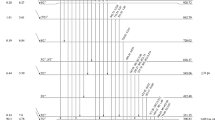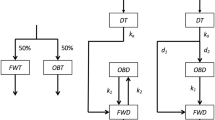Abstract
THE universally used tritium gas exchange method introduced by Wilzbach is of advantage for tritium labelling of many organic compounds which cannot be labelled by the usual exchange reactions, and for which convenient chemical syntheses are not available1,2. Many attempts have been made to obtain products of higher specific activity by the use of extra energy sources such as electrical discharges, γ-rays, microwaves, ultraviolet light and also by iodine catalysis2. However, the advantages of these methods (far less tritium activity to be handled and shorter duration of reaction) have been offset by the concomitant substantial increase in amounts of radiochemical by-products. Wenzel et al. have shown that exposure of charcoal-adsorbed substances to tritium gas results in products of higher specific activity and less by-products2–4. Higher specific activities have also been attained by Meshi et al. by tritiation in the presence of different noble metal catalysts5. These authors exposed mechanical mixtures (1 : 1) of organic compounds with either palladium or platinum black to 100 mc. tritium for 4–22 days.
This is a preview of subscription content, access via your institution
Access options
Subscribe to this journal
Receive 51 print issues and online access
$199.00 per year
only $3.90 per issue
Buy this article
- Purchase on Springer Link
- Instant access to full article PDF
Prices may be subject to local taxes which are calculated during checkout
Similar content being viewed by others
References
Wilzbach, K. E., J. Amer. Chem. Soc., 79, 1013 (1957).
Wenzel, M., and Schulze, P. E., Tritiummarkierung (Walter De Gruyter and Co., Berlin, 1962).
Wenzel, M., Wollenberg, H., and Schulze, P. E., Tritium in the Physical and Biological Sciences, I.A.B.A., 2, 37 (Vienna, 1962). Wollenberg, H., and Wenzel, M., Z. Naturforschung, 18, b, 8 (1963).
Karlsor, P., Maurer, R., and Wenzel, M., Z. Naturforschung, 18, b, 219 (1963).
Meshi, T., and Takahashi, T., Bull. Chem. Soc. (Japan), 35, 1510 (1962).
Tschesche, B., Wulff, G., and Balle, G., Tetrahedron, 18, 959 (1962).
Wenzel, M., Wollenberg, H., and Schulze, P. E., Atompraxis, 7, 89 (1961).
Walens, H. A., Turner, A., and Wall, M. E., Anal. Chem., 26, 325 (1954).
Schulze, P. E., and Wenzel, M., Angew. Chem., 74, 777 (1962).
Author information
Authors and Affiliations
Rights and permissions
About this article
Cite this article
MAURER, R., WENZEL, M. & KARLSON, P. Tritium-labelling of Natural Products. Nature 202, 896–898 (1964). https://doi.org/10.1038/202896b0
Issue Date:
DOI: https://doi.org/10.1038/202896b0
Comments
By submitting a comment you agree to abide by our Terms and Community Guidelines. If you find something abusive or that does not comply with our terms or guidelines please flag it as inappropriate.



